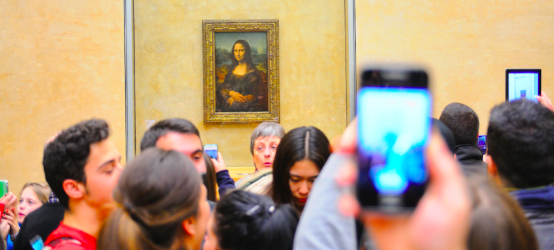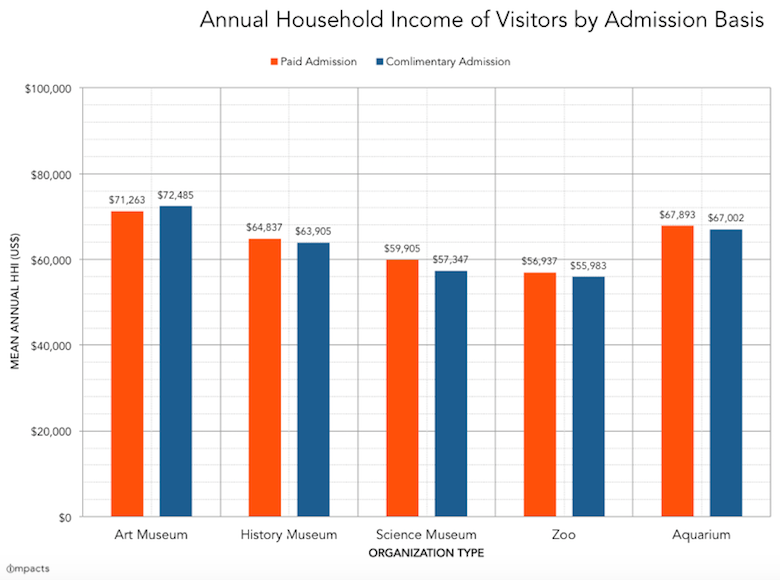
The short answer? No. Here are the numbers.
It stands to reason that if an organization offers free admission, it may be more successful in welcoming lower income visitors. But is this even true? That’s the subject of this Know Your Own Bone Fast Facts video.
Hang onto your hats, folks, because we’re bringing data to what is too often an emotional discussion that can actually hurt access opportunities.
In previous articles, I’ve covered data related to the myth of free admission as a cure-all for visitation to cultural organizations. In regard to the Metropolitan Museum of Art’s recent decision to charge admission for out-of-state visitors, I shared data regarding the average household income of visitors to the Met. In sum, the average household income of people who visit the Met was very similar to the average household income of people who visit other New York art museums that charge admission. But does this finding stand when looking at visitor-serving organization types as a whole in the United States?
At IMPACTS, we collect the average household incomes of visitors to both organizations that offer free admission and those that do not. For this analysis, we looked exclusively at collection-based visitor-serving organizations.
Here’s the average household incomes of visitors to paid admission organizations alongside free admission organizations in 2017. These data come from the National Awareness, Attitudes, and Usage Study as well as ongoing analysis of several organizations and their respective comparative sets. All considered, a total of 74 organizations in the US were contemplated in this analysis, including art museums, history museums, science centers and museums, zoos, and aquariums.

These data do not indicate a significant difference in the annual household incomes of visitors to cultural organizations regardless of if they paid to visit or if they got in for free. Indeed, these data tend to affirm similar findings that an organization that offers complimentary admission generally attracts a similar HHI demographic as an organization that has paid admission basis.
Overall, organizations that feature a complimentary admission policy serve visitors with household incomes only 1.3% lower than visitors to organizations with paid admission. This variance is not significant, and reaffirms that the choice to visit (or not to visit) an organization generally has more to do with topic interest or not feeling welcome than perceived cost-related barriers.
Those looking closely at the chart will notice that visitors who did not pay to visit art museums contemplated in this analysis have 1.7% higher household incomes than those who paid to visit an art museum. That’s also not a statistically significant variance. When we pulled the data for year 2016, paid admission HHI was higher – and also by a similar, not significant margin. The point isn’t in the 1-2% either way – it’s that there isn’t a significant difference in average household income based on admission basis.
“But people who cannot afford an admission fee cannot visit a paid admission museum.” Of course! And certainly, it stands to reason that sometimes those who cannot afford admission may visit a free admission organization! That said, there aren’t enough of them to significantly lower the average household income of visitors to these different types of organizations.
People who visit cultural organizations tend to be the kind of people who visit cultural organizations
How can it be that the difference is not significant? The truth is that both of these types of organizations (i.e. paid admission basis and free admission )attract a similar demographic. A person who is likely to visit an art museum is the kind of person likely to visit an art museum. For these people, cost is not a primary barrier to visitation.
If people don’t want to visit in the first place, then it may not matter if admission is free. People report than their time is more valuable than their money.
A certain type of person visits cultural entities. Because the demographic of the United States has shifted, there’s an urgent need to change up that visitor profile and attract more diverse attendees and cultivate them as visitors and supporters.
Thinking that free admission results in visitors of a lower household income overestimates the role of cost as the primary visitation barrier for people who do (or don’t!) want to attend these organizations. The decision to visit a cultural organization is more a function of lifestyle than of finances.
Being free is not the same as being welcoming, and free admission – in and of itself – does not automatically bring lower income folks through the door.
Being welcoming is bigger that free admission. It’s done by utilizing revenues (by way of government support, grants, philanthropy, admissions, etc.) to invest in a culture of inclusion. Reaching income-qualified audiences, specifically, requires targeted programs that actually work.
While it’s tempting to think that putting a “free admission” sign on the door will significantly increase long-term attendance and serve as an effective affordable access program at the same time, data suggest that it’s just not the case.
This is too often an emotional discussion. I think that is because, when we realize that free admission itself isn’t the key to attracting income-qualified audiences, specifically, then we cannot hide anymore. We need to do something much harder that involves a strategic rather than tactical fix: We need to be more relevant and enticing and engaging for those audiences. We need to strap on our thinking caps tighter.
I believe that we can do that! But first, it may helpful to get professionals on the same page.
Free admission can be sustainable and ideal! But even free organizations may benefit by considering that a free admission policy is not necessarily a fully formed access program.

